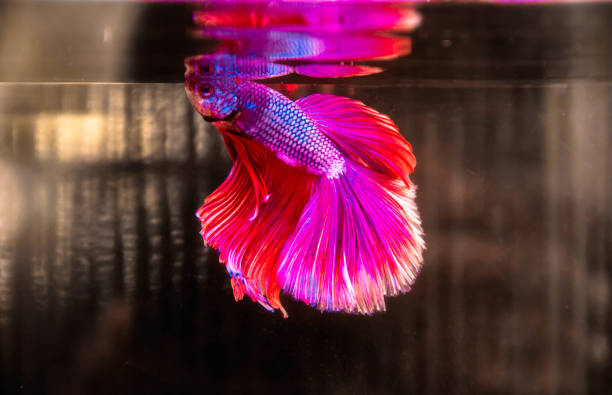Betta Fish Rotting Fins Treatment: Causes, Prevention & Tips
Betta fish are generally considered to be pet fish. They are small, colorful, and have a mild temperament. Although they are easy to care for and can live in a variety of environments, betta fish fins can rot quickly if the fish is not getting the proper treatment.
There are a few things that you can do to help treat the fins and keep them healthy. You can soak the fins in a solution of baking soda and water, or use a fin-rotting medication. A good way to keep the fins healthy and save money on medication is to feed your betta fish a diet of frozen blood worms, brine shrimp, or krill.

Table of Contents
What Causes Betta Fish Fin to Rot?
Betta fish fins rot or die, as a result of several different factors. Some of the most common causes of fin rot in bettas are poor water quality, over-feeding, and poor tank conditions. Bettas are sensitive fish and can’t tolerate a lot of environmental stressors. If your tank is not set up properly or if the water quality is poor, your betta will be unable to fight off the bacteria and fungus that cause fin rot.
Bacteria
Bacterial fin rot is a bacterial infection of the fins of fish. It is a serious problem, and can quickly lead to the death of the fish. The cause is usually bacteria, but can also be caused by parasites. The bacterium is found in both fresh and saltwater and can be spread through contact with infected fish or water. The first sign of bacterial fin rot is usually a change in the color of the fins. This change may be gradual, or it may be sudden and dramatic. The fins may turn black, green, or brown, and may start to rot.
Fungi
While bacteria are the main cause of fin rot, it can also be caused by a fungal infection. Fungal fin rot is a common problem with betta fish. The fungus grows on the fish’s fins and causes them to rot. The fins can fall off, and the fish may have difficulty swimming. There is no cure for this disease, but there are treatments that can help prevent it from getting worse. Treatment for fin rot will depend on the cause. If the fin rot is caused by a fungal infection, treatment will typically involve using a fungicide to kill the fungus. If the fin rot is caused by bacteria, treatment will typically involve antibiotics.
Stress
Another common cause of fin rot is stress. Fish are sensitive, and can’t handle a lot of environmental stressors. Poor water quality, over-feeding, and overcrowding all contribute to the stresses that fish experience. When these stresses are combined with a bacterial or fungal infection, it can lead to fin rot.

How Do I Know if My Fish Has Fin Rot?
If you notice any symptoms of fin rot, such as sunken eyes or flesh that is black and brittle, your fish may be in trouble. You can also check to see if the fins are covered in algae or fungus. If so, your fish may need medical attention. If you notice your betta fish’s fins are rotting, there is a good chance that the fish has fin rot.
What Are the Symptoms of Fin Rot?
The symptoms of fin rot can vary depending on the fish’s age, size, and environment. Generally, fin rot will cause a fish to lose its fins and/or scales, which can make it difficult for the fish to swim or feed. Fish that are infected with fin rot may also exhibit cloudy eyes, sunken eyes, and a lack of appetite. If you notice that the fins on your betta fish are disintegrating, it is important to take them to a vet immediately for treatment.
Mild Fin Rot
Mild fin rot is a condition that affects the fins of bettas. It is caused by a bacterial infection and can lead to the fish losing its balance and swimming in circles. Treatment usually involves antibiotics, and the fish may need to be isolated from other fish while it is being treated.
Major Fin Rot
Betta fish fins can rot and fall off if the fish is not treated. The fins will become slimy and black, and the fish will be unable to swim or feed. Treatment usually involves antibiotics and a special diet.
Severe Fin/Body Rot
Betta fish rotting fins are a common problem in the fishkeeping community. The fins on a betta fish can easily rot and fall off, causing the fish to look very sick. There are a few symptoms of severe fin rot, and the best way to treat it is usually with antibiotics.
How to Treat Betta Fish Fin Rot?
There is not much you can do to prevent bacterial fin rot, but there are some things you can do to help protect your fish. Always wash your hands before handling your fish, and avoid cleaning the tank with harsh chemicals. Keep plenty of fresh water in the tank, and clean out any debris regularly.
Regular Treatment
It is important to treat fin rot in your betta fish regularly, as the infection can quickly spread. Treatments such as antibiotics will help to kill the bacteria that is causing the disease, and saltwater solutions can help stop the spread of the fungus.
Mild Betta Fin Rot Treatment
Betta fish are often kept in small tanks with few hiding places, which can lead to fin rot. Fin rot is a condition where the fins on the Bettas become discolored and brittle. There are a few treatments that can be done to help treat fin rot, but the most common is to give the Bettas a mild bath in warm water with Epsom salts.
Major Betta Fin Rot Treatment
Betta fish fins may rot if the water temperature is too high or if the fish is not getting enough oxygen. To treat major betta fin rot, you will need to give the fish antibiotics and a mineral supplement. You will also need to change the water regularly and provide a hiding place for the fish.
Severe Fin/Body Rot Treatment
Betta fish are prone to fin rot, a condition in which the fins on the fish rot and fall off. The condition is caused by a variety of factors, including poor water quality, overcrowding, and poor diet. Treatment for fin rot typically includes antibiotics and a treatment for the underlying cause.
Quarantine Tank
One way to help prevent the spread of fin rot is setting up a quarantine tank. The tank should be set up with cool, fresh water and treated with antibiotics before adding any fish. This will help to stop the spread of the infection in your other fish.
Aquarium Salt
Aquarium salt is a common treatment for betta fish fin rot. It is effective in killing the bacteria that causes the disease, and it can help to improve the healing process. It is important to use aquarium salt correctly, however, as too much can be harmful to your fish.
Bettafix & Melafix
BettaFix and Melafix are both medications used to treat fin rot in bettas. Bettafix is a liquid medication that is applied to the affected fins, and Melafix is a granular medication that is applied to the affected area. Both medications work by stopping the growth of the fungus that is causing the fin rot.

How to Prevent Betta Fish Fin Rot?
Betta fish fins can rot from a variety of causes, but one of the most common is poor water quality. If your betta fish is swimming around in dirty water, it’s likely to develop fin rot. There are a few things you can do to help prevent this from happening:
- Make sure your betta fish has access to a good quality filter. A good filter will help to clean the water and remove harmful toxins.
- Change your betta fish’s water regularly. If the water is dirty, it will be difficult for the fish to clean its fins.
- Keep your betta fish healthy by providing it with plenty of food and water. A healthy betta fish will be less likely to get fin rot, and it will also live for a longer time.
- Keep your betta’s water temperature comfortable and stable.
- Monitor your betta’s water chemistry regularly.
- To keep betta fish healthy in general, always remember not to overcrowd your tank with too many other fish or exotic creatures.
Can Betta Fish Heal Naturally From Fin Rot?
Yes, betta fish can heal from fin rot on their own. However, it may take some time for the fins to fully recover and they may not be as active as they were before the infection. Besides, if one of the other fish in the tank is sick, it can easily spread the disease to the betta fish. Provide your fish with plenty of food and water and be patient as they work to repair their damaged fins.
How to Tell if Fin Rot Is Getting Better?
If the fin rot is getting better, your betta fish will be spending more time swimming around and less time lying down. Additionally, their fins should start to feel stiffer and less floppy than they were before the infection occurred. However, if you notice any other concerning signs such as discharge from the fish’s mouth or a behavior change (especially aggression), it is best to take them to a vet for further inspection.
Do Fins Grow Back After Fin Rot?
Betta fish fins can rot and fall off, but fortunately, the fins usually grow back. Fins typically grow back after fin rot. However, the fins may not be as strong or agile as they were before the infection occurred. After the infection of the fin rot, there are a few things you can do to help him grow back his fins faster: make sure the tank is clean and well-filtered, provide plenty of fresh water and food, and give your betta some space to swim.
Is Fin Rot Dangerous to Other Fish?
Many betta fish owners are familiar with fin rot, but may not be aware that it is also contagious to other fish in the tank. Fin rot is a bacterial infection that typically affects the fins of betta fish. The infection is spread through direct contact between infected fish or through the water they swim in. Although fin rot is contagious, it is not always fatal to other fish in a tank. If your tank contains other healthy betta fish, it is important to keep an eye on them and take appropriate steps to treat any infected fish.
Can Fin Rot Kill a Betta?
Fin rot is a bacterial infection that can quickly kill betta fish. The disease causes the fins to rot and fall off and often results in the fish dying. Fin rot is most common in betta fish kept in warm, moist environments, such as in a fish tank with a poor filtration system. Treatment for fin rot includes antibiotics and water changes to improve the fish’s environment.